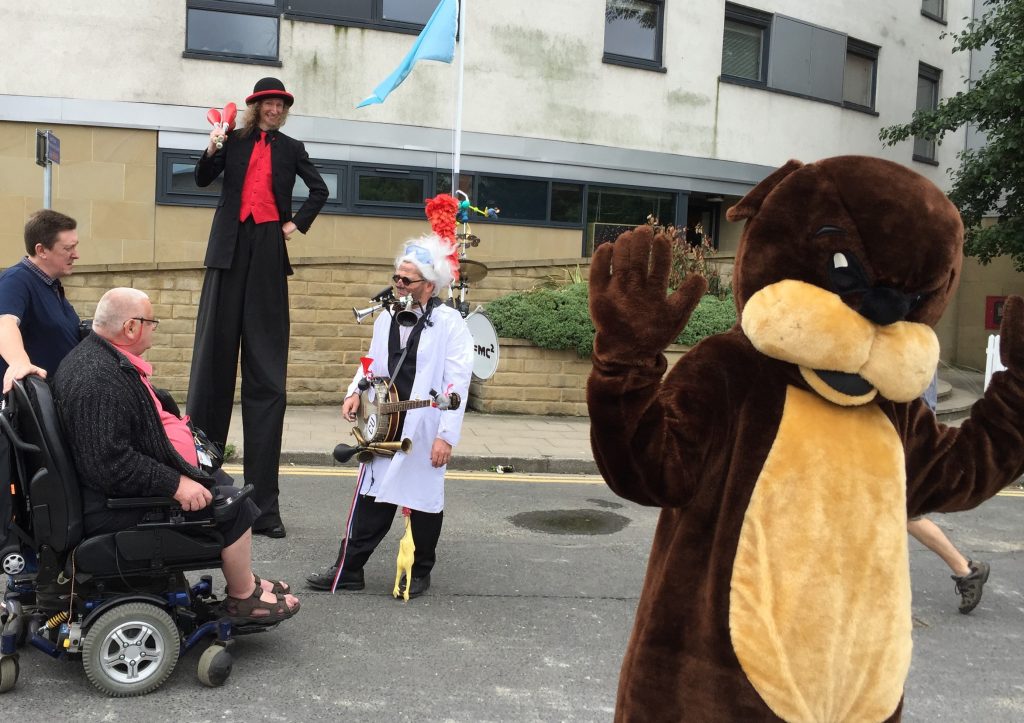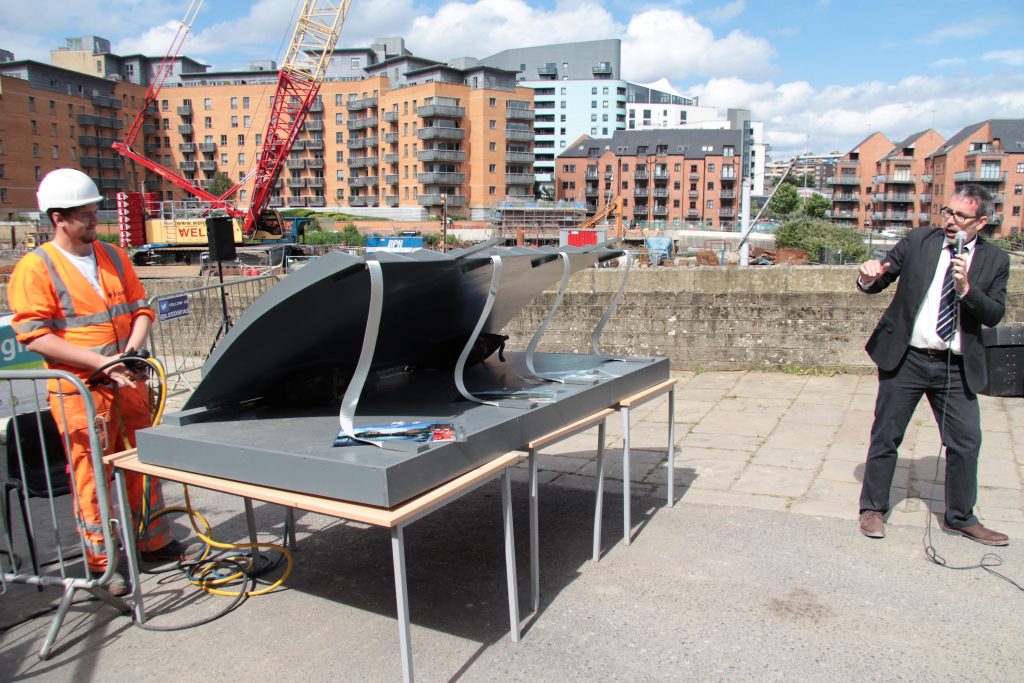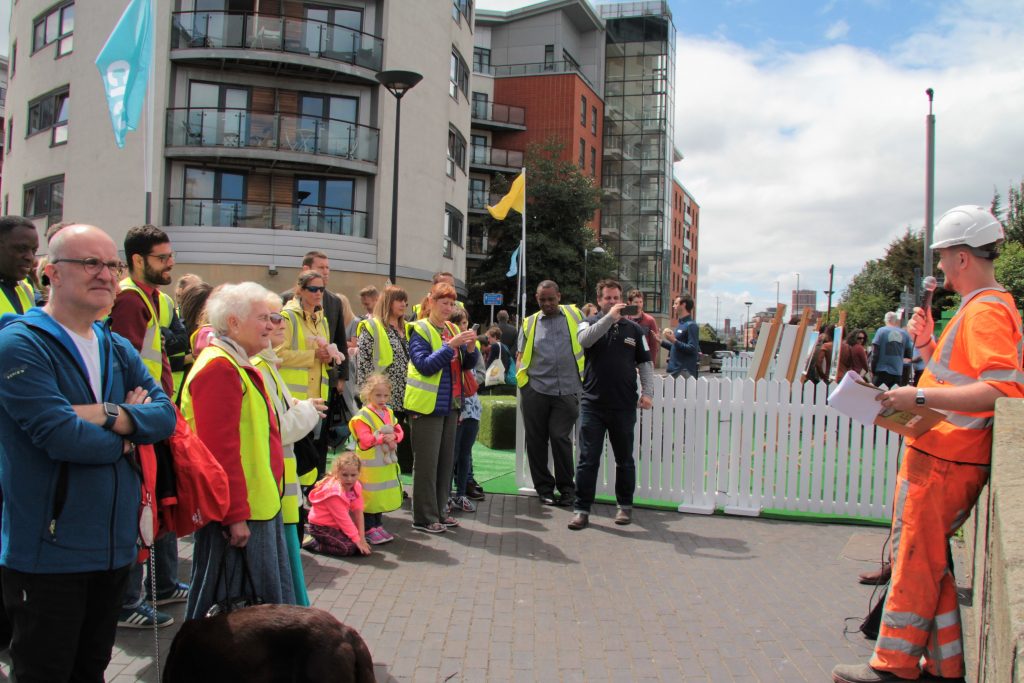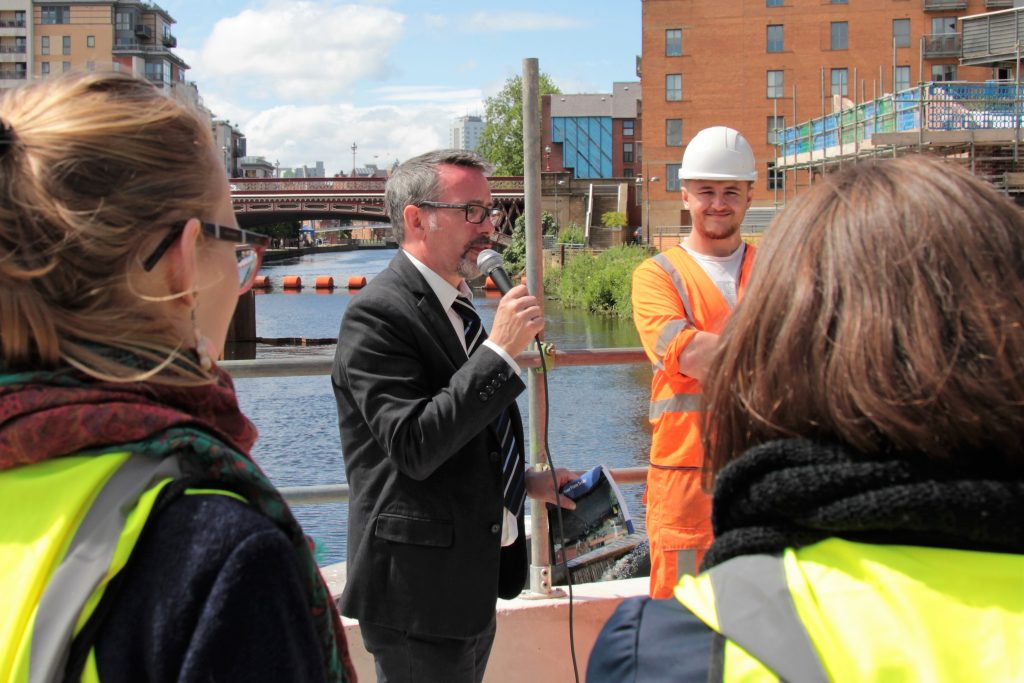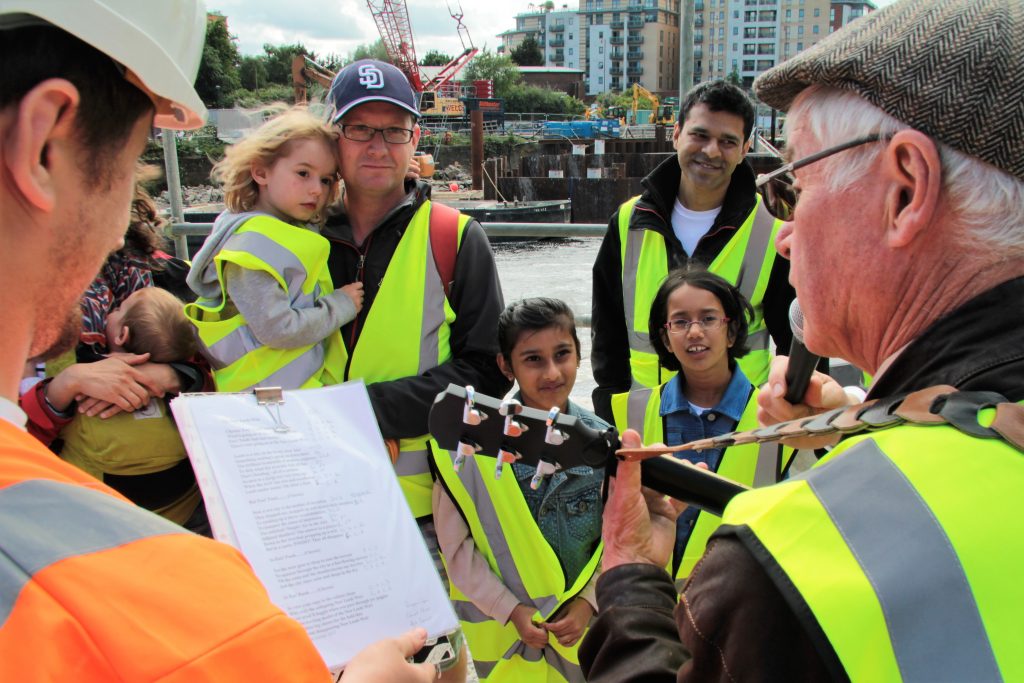Quod Erat Demonstrandum. QED. These three letters are usually used when something has supposedly been proved – but the phrase literally means “that which has been (or is to be) demonstrated”. Well, at Leeds Waterfront Festival, last weekend but one, we set out to demonstrate (without ‘proving’) how the Leeds Flood Alleviation Scheme’s brand new weir at Crown Point operates. Through the medium of street performance. And therein lies a tale…
In the first part of this two-part blog, I looked at the FAS scheme itself, and took you, dear reader, on a backstage tour of the heavy engineering work still continuing at Crown Point — in the middle of the River Aire — to install the new weir. But why was I, a drama professor, given this access to the site? It all goes back to an unexpected conversation with BAM Nuttall’s FAS project director Andy Judson, over lunch at a networking event last November. On that occasion, I found myself describing to Andy our contribution to Leeds Waterfront Festival 2016, the promenade performance After the Flood — during which plans for the new weir were demonstrated using a clipboard and a balloon… (as seen below, in a scene featuring Nick DeJong and Joe Large). It was shame, I said to Andy, that the moveable weir mechanism itself couldn’t be demonstrated to the public, because (a) it’s underwater and (b) it will only be operated in potential flood conditions. When I said that, though, you could sort of see a light bulb illuminating over Andy’s head. “Maybe we could demonstrate it,” he said, “by building a mock-up model at ground level during the festival…”
And here is the mock-up model, as exhibited the day before the Festival by BAM foreman Mark Pheasey (left) and two colleagues including stakeholder relations manager Jonathan Bulmer (right). The model was originally going to be much larger — on the same scale as the real thing, and using one of the actual air bladders that will go into the weir installation (as seen below – the black rubber bladders stacked next to the metal weir plates at the FAS compound to the east of the city centre…).
In the event, though, there were logistical problems with the full-scale plan, so Mark Pheasey dreamed up the scaled-down model using painted hardboard for the weir plate (which really does look like the real thing – as you can see) and some much smaller air bags, which didn’t have to support the weight of the River Aire! Actually I think this worked much better than the full-scale model might have, because the air-bags in the mock-up could inflate and deflate in seconds, raising and lowering the hardboard weir, whereas the big bladder would have taken at least half an hour to inflate fully. Much better for demonstration purposes!
 So this is the model in situ at the weekend, on the left (weir plate up), being explained to two members of the public by one of the volunteering FAS staff (the people with white patches on their T-shirt sleeves). On the far right is Andy Judson himself, chatting to the Environment Agency’s Mark Garford and others. The FAS team were on hand all weekend, in different combinations, to chat to the public about the scheme from a more official, technical point of view — using the model as a point of focus.
So this is the model in situ at the weekend, on the left (weir plate up), being explained to two members of the public by one of the volunteering FAS staff (the people with white patches on their T-shirt sleeves). On the far right is Andy Judson himself, chatting to the Environment Agency’s Mark Garford and others. The FAS team were on hand all weekend, in different combinations, to chat to the public about the scheme from a more official, technical point of view — using the model as a point of focus.
It became clear that word of the model demonstration had spread to some pretty influential places. Above is Hilary Benn, Labour MP for Leeds Central, who seemed genuinely fascinated by the scheme when he turned up early on the Saturday morning. And on the Sunday, Richard Parry, the Chief Executive of the Canal and River Trust (formerly British Waterways) also stopped by to see what we were doing (at which point I shamelessly asked for a picture with him…).
Despite this interest at policy level, though, the mock-up model and uniformed FAS team still looked — as they themselves put it to me — somewhat “dry” and “worky” for a festival weekend. Somehow the general public had to be engaged a little more eye-catchingly, and this is where Weir Science came in ….
… that’s the name we gave to the creative elements we built around the FAS model. “We” being Multi-Story Water and Open Source Arts, in Kirkstall, which is run by Phil Marken (one of the leading lights in Leeds’s voluntary flood response after the inundation of Boxing Day 2015). Phil himself wasn’t available at the weekend, but he had arranged for “graphic harvester” Jon Dorsett – above – to be on hand to gradually build up a visual record of the activities as they occurred, on four white boards that BAM staff had fastened to the open gate of their compound. The first thing Jon did was draw this appealing, cartoonish logo for us – to catch the eye of passers-by… (I love that he even hand-drew all the logos… a lovely counterbalance to the ‘official’ signage).
Phil had also consulted his address book of street performers and come up with one-man-band Jake Rodrigues, aka “Shabby Jake”, aka Professor Leaky-Faucet. This last was a new identity and ‘look’ that Jake created for us this weekend, inspired by the Weir Science title and by every mad scientist you’ve seen in books and movies… In fact Jake’s entire set was tweaked for context, as he engaged crowds in (seemingly) spontaneous renditions of “songs with weir in the title”… from Queen’s “Weir the Champions” to Vera Lynn’s “Weir Meet Again”, via the Pointer Sisters’ “Weir Are Family”, and many others. The results were hilarious, as were Jake’s various bits of improvised schtick about the weir model (“it’s a giant cheese toastie maker”) and explanations about the risks involved in flooding Leeds with custard…
In the picture above, taken on the Sunday, Jake is chatting with passers-by while accompanied by another of Phil’s recommendations — stilt-walker Nik, aka Das Isobar. The job of these two, whom I briefed carefully in advance, was to deliver a version of their usual act — wandering out and about in the immediate Leeds Dock area to attract attention — while also trying to encourage people towards the weir demonstration area. They did a tremendous job of this, by blending visual appeal with conversational wit. One of my favourite moments of the weekend was watching Nik, from the top of his stilts, chatting animatedly with a man from the Netherlands, who (craning up to look at him) was explaining in detail the history of his country’s reactions to the 1997 floods that engulfed about a third of their landscape… (Nik was only with us for the Sunday: on Saturday the same role was filled by an excellent contact juggler, Steve the Pirate, although I don’t have any good pics of him unfortunately.) Oh and also in the picture above, there’s the otter…
The otter costume belongs to the Environment Agency, apparently, and is often used at public engagement events. Here it is worn by Rosa Foster, one of the EA’s senior flood risk management officers, who found herself oscillating between waving goofily with the head on, and then lifting it up to explain details to passers-by… Rosa made the interesting point to me, though, that when she first put the costume on at the start of the day, people were waving at her, or posing for pictures with their kids, but weren’t readily being pulled in to talk about flood alleviation. After Jake and Nik started up, though, she found that the engagement process became much easier. Andy Judson made much the same point, telling me that the performers succeeded in creating a much “softer landing” for the FAS team’s more technical explanations … Once drawn in by the sense of fun, spectacle and banter, people were much more willing to express their curiosity about the weir itself… and some great conversations then followed. Throughout the weekend it became clear that the FAS team were having a great time chatting with people, since the level of interest was so much greater than they’re used to.
Here’s Professor Leaky-Faucet again (above), in the midst of the “pre-show” set that he delivered six times over the course of the weekend, before each of our Weir Science walking tours (starting at 12.30, 2.00 and 3.30 each day). On the occasion below, he was also accompanied by Nik — down off his stilts and doing his object manipulation routine. At one point this involved commandeering a child’s remote control joystick box, and appearing to use it to “drive” a wheelchair-user around in circles… this man played along gamely to hilarious effect (he was of course really operating his own chair!) .. thereby totally upstaging Jake!
Jake’s crowd-gathering set would end, each time, with him delivering his stompy, one-man-band version of the theme tune to the 1980s teen movie Weird Science — now renamed “Weir Science”…
… here are his lyrics, which stage manager Jenny and I (above) would point out with our fingers as he went… rather like the bouncing ball on karaoke lyrics…
As soon as Jake finished his song, I would then take over in my role as “Guy…from the Council” (complete with carefully selected hush puppies). Accompanied by “my glamorous assistant Jack” (“of all trades”) in head-to-toe BAM orange, we would then demonstrate the weir model before inviting people to come with us on a tour around the real thing… Jack (played by the aptly named Jack Waterman) would then read a mock safety briefing, during which people joining us were invited to put on hi-viz vests…
… and a surprising number of people proved willing to do just that (even though we made clear that the vests were optional – still it was a useful way for us to identify our audience on the move). Our first stopping point on the tour was a spot just by the river, where Jack would explain how the crane on Fearns Island had been erected – while also having a sly go at “men in suits and ties”, such as myself, who under-estimate the skills and expertise of construction workers such as himself…
My script for this was based on a gently satirical reading of the research interviews I’d done as preparation: the idea was to bring a human side to the story, to offset and balance out our more technical explanations.
And then it was off across Knights Way Bridge… stopping part-way across to get a good look at the weir itself — currently half-completed… Here we discussed what exactly a coffer dam is, and spoke in some detail about the scheme’s benefits for wildlife…
At one point, “Guy” even attempted to explain the possible reappearance of lamprey in the Aire by demonstrating with a visual aid …
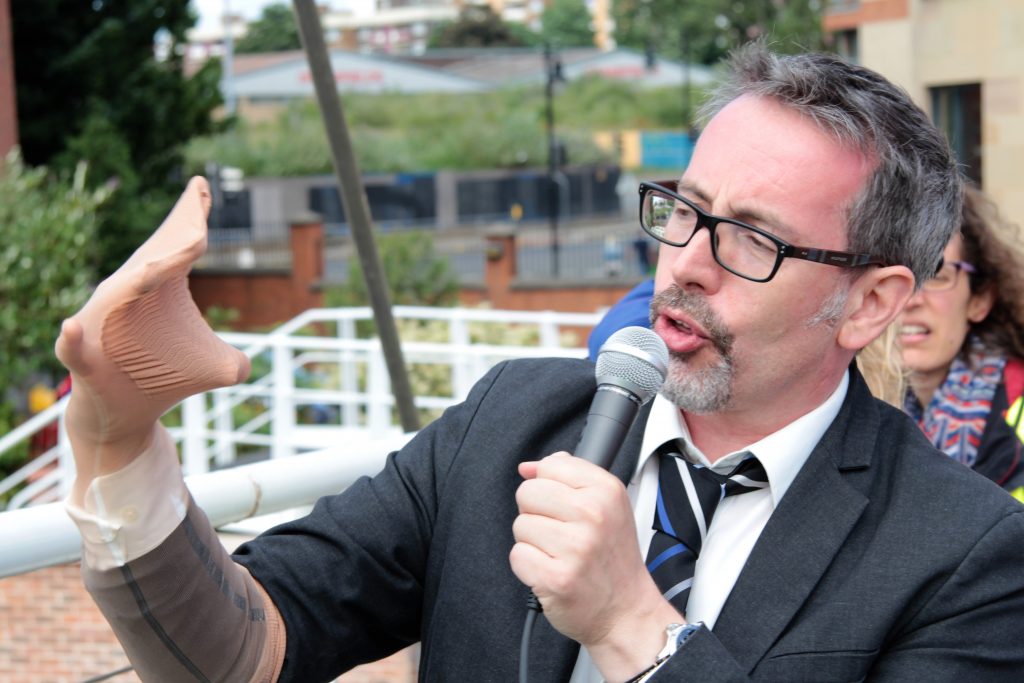 After completing our crossing of the bridge, we stopped outside the Turlow Court apartment building — badly hit during the Boxing Day flood of 2015 — to reflect on some of the residents’ feelings about the flood alleviation scheme (which are generally very positive, despite the temporary inconveniences involved with the construction process).
After completing our crossing of the bridge, we stopped outside the Turlow Court apartment building — badly hit during the Boxing Day flood of 2015 — to reflect on some of the residents’ feelings about the flood alleviation scheme (which are generally very positive, despite the temporary inconveniences involved with the construction process).
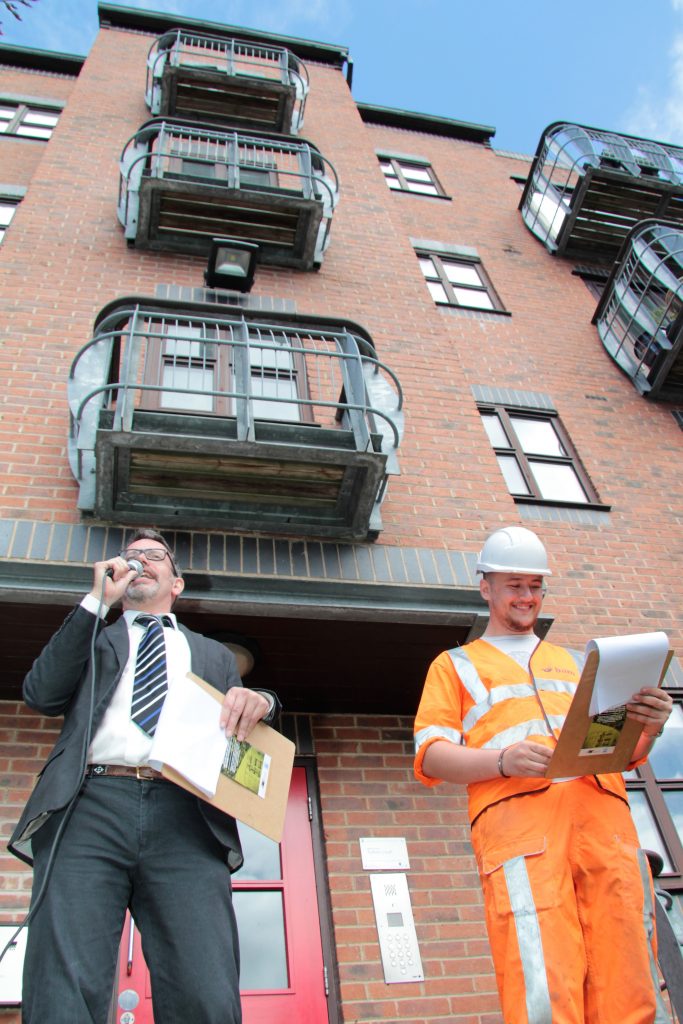 Then, for our last stop, we brought the audience to a spot directly overlooking the new weir. This was within a fenced-off construction area, which had been specially tidied and made safe for us, for the weekend, by BAM staff.
Then, for our last stop, we brought the audience to a spot directly overlooking the new weir. This was within a fenced-off construction area, which had been specially tidied and made safe for us, for the weekend, by BAM staff.
Here, Jack and I shared various anecdotes, including the story of the moorhen who had made her nest against the upstream side of the part of the sheet piling used to construct the coffer dam for the first (now complete) section of the weir works… Since the nest could not be removed, either legally or morally, when they came to take the coffer dam down, the FAS team had to find a way of working around it — at some considerable cost and expenditure of time. And yet there are now moorhen chicks swimming happily around — who appeared right on cue for one of the Sunday performances, much to the delight of the audience! (I don’t have a picture of them, but here is a tern that stage manager Jenny spotted on the weir…)
 Finally, to wrap up, my good friend Eddie Lawler would appear to sing his brand new song, written for the occasion, “The New Leeds Weir”. This had a great, catchy chorus involving making the imagined sounds of the weir moving (“Psst! Fsssh! Bub-bub-bubble! What’s going on at at the New Leeds Weir?”) which many audience members merrily joined in with. It was a lovely, relaxed way to conclude the presentation.
Finally, to wrap up, my good friend Eddie Lawler would appear to sing his brand new song, written for the occasion, “The New Leeds Weir”. This had a great, catchy chorus involving making the imagined sounds of the weir moving (“Psst! Fsssh! Bub-bub-bubble! What’s going on at at the New Leeds Weir?”) which many audience members merrily joined in with. It was a lovely, relaxed way to conclude the presentation.
And then, before departing, many audience members wanted to stand around some more, look at the weir and the river, and ask further questions…
Back at the starting point, Jon gradually built up a visual representation of some of the feedback we received over the course of the weekend… Some of it related to people’s thoughts about the weir installation itself, and some of it was feedback on the way we’d presented and explained it to people. My favourite is: “Unexpectedly, I really enjoyed that!”
A huge thankyou to everyone who collaborated on putting this weekend together — to Andy, Jonathan, Mark and everyone at BAM… to Rosa, Mark Garford and others at the EA… to my “sidekick” Jack Waterman, to Phil Marken and Open Source arts, stage manager Jenny, street performers Nik and Steve, and of course two very different musicians who wrote original material for the occasion… Jake and Eddie… Thanks all!
By the end of the weekend, Jon had pretty much filled up that big expanse of whiteboard, and it was the last thing to get dismantled on the Sunday. I gather it might get preserved as a mural in a meeting room somewhere. So I made sure Jon signed it, bottom right corner. QED.







